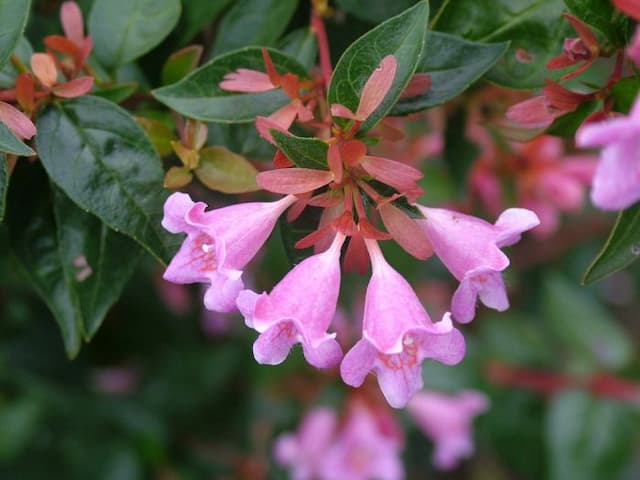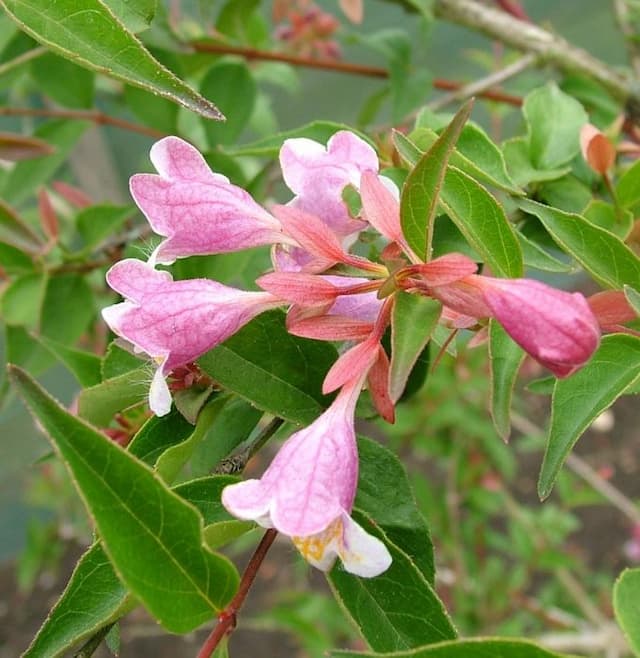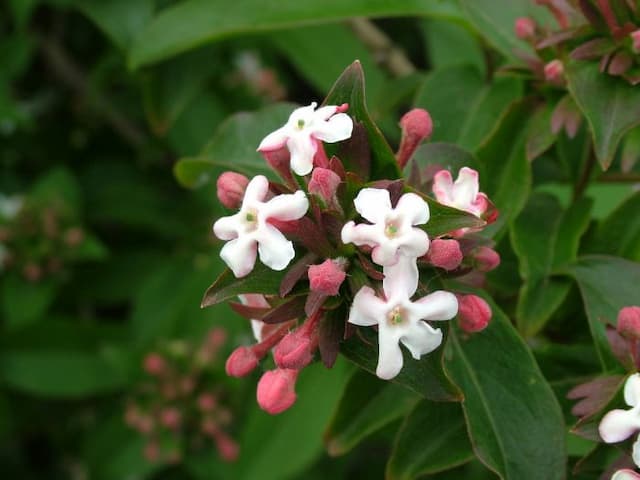Golden Weigela Weigela 'Looymansii Aurea'

ABOUT
Weigela 'Looymansii Aurea' is an ornamental shrub with a visually striking presence in the landscape. It is characterized by its beautiful golden-yellow foliage which brings a bright splash of color to any garden. The leaves are oval-shaped with a slightly serrated edge and possess a luminous quality that can appear to glow in the sunlight. During the blooming season, which typically occurs in late spring to early summer, the plant produces an abundance of trumpet-shaped flowers. These blossoms are a soft pink to rosy hue and can be quite prolific, covering the shrub in a flush of color. The flowers are especially attractive to hummingbirds and butterflies, adding an extra layer of life and vibrancy to the plant's display. The overall structure of Weigela 'Looymansii Aurea' is rounded and bushy, with branches that arch gracefully. The intertwining of the golden leaves and the pastel flowers creates a pleasing contrast that can complement a variety of garden styles and other plantings. This deciduous shrub has a natural resilience and can add lasting interest to the landscape across different seasons as its foliage transitions in color, eventually shedding leaves in preparation for winter.
About this plant
 Names
NamesFamily
Caprifoliaceae
Synonyms
Golden Weigela, Gold Leaf Weigela
Common names
Weigela 'Looymansii Aurea'.
 Toxicity
ToxicityTo humans
Weigela is not commonly known to be toxic to humans. However, as with many plants, it is recommended to avoid ingestion because the potential for plant toxicity to humans can vary based on individual sensitivity or allergy. If any part of the Weigela plant is ingested and symptoms of poisoning appear, such as gastrointestinal discomfort, consult a medical professional.
To pets
Weigela is not widely recognized as a toxic plant to pets. Ingesting parts of this plant may sometimes cause mild gastrointestinal upset in sensitive animals due to the unfamiliar plant matter. If your pet ingests Weigela and shows signs of distress or poisoning, such as vomiting or diarrhea, it is advisable to contact your veterinarian.
 Characteristics
CharacteristicsLife cycle
Perennials
Foliage type
Deciduous
Color of leaves
Golden
Flower color
Pink
Height
6 feet (1.8 meters)
Spread
6 feet (1.8 meters)
Plant type
Shrub
Hardiness zones
4
Native area
Asia
Benefits
 General Benefits
General Benefits- Attractive Foliage: The Weigela has golden-yellow leaves that add color and visual interest to the garden throughout the growing season.
- Showy Blooms: It produces pink to red trumpet-shaped flowers in late spring to early summer that are appealing to both gardeners and pollinators.
- Habitat for Wildlife: The flowers provide nectar for hummingbirds, bees, and other pollinators, making it a beneficial plant for supporting local ecosystems.
- Easy to Grow: This plant is known to be hardy and low maintenance, making it suitable for gardeners at all levels of experience.
- Versatile Landscaping: Its size and shape make it perfect for use in a variety of landscaping designs, including borders, hedges, and as a stand-alone specimen.
- Drought Tolerant: Once established, the Weigela can tolerate periods of drought, contributing to its low-maintenance nature.
- Seasonal Interest: Apart from its bright spring flowers, the Weigela can also offer interesting foliage color in the fall, depending on the cultivar.
 Medical Properties
Medical PropertiesThis plant is not used for medical purposes.
 Air-purifying Qualities
Air-purifying QualitiesThis plant is not specifically known for air purifying qualities.
 Other Uses
Other Uses- Weigela can be utilized as a natural fence or property boundary due to its dense foliage and rapid growth habit, providing both privacy and aesthetic appeal.
- This plant's branches may be used for crafts, such as wreath making or as a natural material in basket weaving, adding a unique touch to handmade items.
- The dense structure of Weigela makes it a suitable habitat for birds, providing them with shelter and a nesting area within the garden.
- When pruned correctly, Weigela can be trained into a small tree form, becoming a focal point in a landscape design.
- The vibrant foliage of the Weigela can be used as a backdrop in photography, offering a lush and colorful setting for outdoor portraits.
- In larger gardens, Weigelas can be planted in mass to create a dramatic display of colors when they bloom, enhancing the overall visual impact of the space.
- The plant can be used in sensory gardens because of its textured leaves and the gentle rustling sound they produce in the wind, providing auditory stimulation.
- Weigela may serve as a natural sound barrier in urban settings, where its dense growth can help reduce traffic noise.
- Its resilience to pruning makes it suitable for topiary, allowing gardeners to create varied shapes and designs within a landscape.
- The flowers of Weigela can be added to compost piles to introduce more organic matter, improving the nutrient content and structure of the compost.
Interesting Facts
 Feng Shui
Feng ShuiThe Weigela is not used in Feng Shui practice.
 Zodiac Sign Compitability
Zodiac Sign CompitabilityThe Weigela is not used in astrology practice.
 Plant Symbolism
Plant Symbolism- Optimism: The vibrant yellow foliage of the Weigela often represents positivity and a sunny outlook on life.
- Adaptability: Capable of thriving in various conditions, this plant symbolizes the ability to adapt to different environments and situations.
- Romance: With its charming flowers, Weigela is commonly associated with love and can be a symbol of an enduring romantic bond.
- Grace: The arching branches and elegant blooms signify grace and can suggest both inner and outer beauty.
- New Beginnings: Since the Weigela blooms in spring, it represents renewal and the start of new endeavors or phases in life.
 Water
WaterGolden Weigela needs regular watering, particularly during dry spells, but be careful not to overwater. In general, watering deeply once a week is sufficient, providing about 1-2 gallons per plant depending on the soil type and weather conditions. During the hotter months, you may need to water twice a week if the soil dries out quickly. It's important to allow the soil to dry slightly between waterings to prevent root rot. Use a soaker hose or drip irrigation for best results, as this helps to deliver water directly to the root zone and minimizes evaporation.
 Light
LightGolden Weigela thrives in full sun to partial shade. The ideal location would provide at least 6 hours of sunlight daily, which encourages abundant flowering and maintains vibrant leaf color. However, in particularly hot climates, some afternoon shade can help prevent leaf scorch.
 Temperature
TemperatureGolden Weigela is hardy and can handle a range of temperatures, growing best between 50°F and 75°F. It can survive minimum winter temperatures down to -20°F. It's important to avoid exposure to extreme cold or frost after new growth begins in the spring, as this can damage the plant.
 Pruning
PruningPrune Golden Weigela immediately after flowering, typically in late spring or early summer, to keep the plant looking tidy and to encourage next year's blooms. Remove any dead or crossing branches and shape as desired. Pruning is also a good time to thin out the plant if it's becoming too dense, which helps improve air circulation.
 Cleaning
CleaningAs needed
 Soil
SoilThe Weigela prefers a well-draining soil mix, rich in organic matter. A mixture of garden soil, peat moss, and compost will provide a nutritious base for the Weigela 'Looymansii Aurea'. For best growth, maintain soil pH between 5.5 to 7.5, slightly acidic to neutral.
 Repotting
RepottingGolden Weigela generally does not require frequent repotting and should be repotted once it has outgrown its current container or every 3-5 years. Early spring, just before new growth starts, is the best time to repot this plant.
 Humidity & Misting
Humidity & MistingGolden Weigela thrives in average outdoor humidity conditions. It does not have specific humidity requirements, making it adaptable to various outdoor environments as long as extreme dryness is avoided.
 Suitable locations
Suitable locationsIndoor
Place in bright, indirect light and ensure large enough space indoors.
Outdoor
Full sun to partial shade with well-draining soil, and regular pruning.
Hardiness zone
4-8 USDA
 Life cycle
Life cycleWeigela 'Looymansii Aurea', commonly known as Golden Weigela, begins its life as a dormant cutting or seed before it germinates and starts its growth as a seedling. It then develops into a young plant with its characteristic golden-to-light green foliage. As it matures, it enters a vegetative stage during which it experiences significant growth both in height and spread. The adult Golden Weigela reaches its flowering stage usually in late spring to early summer, producing trumpet-shaped pink blossoms that attract pollinators such as bees and butterflies. After pollination, it may produce small, inconspicuous fruit, although the plant is primarily grown for its foliage and flowers. As a deciduous shrub, it enters a period of dormancy in the fall when the leaves drop, and it remains in this state through the winter until the cycle begins anew with spring growth.
 Propogation
PropogationPropogation time
Spring-Early Summer
The Weigela 'Looymansii Aurea', commonly referred to as Golden Weigela, is a deciduous shrub that is most commonly propagated through softwood cuttings. This method typically takes place in late spring to early summer when new growth is soft and flexible. To propagate, a gardener would take a cutting of about 4 to 6 inches (approximately 10 to 15 centimeters) long from a healthy stem, making sure it includes at least two or three sets of leaves. The lower leaves are removed, and the cut end can be dipped in a rooting hormone to encourage root development. The cutting is then planted in a moist soilless mix, ensuring to keep the environment humid and warm. Within a few weeks, the cutting should begin to root. This method is popular for its simplicity and effectiveness in producing new, genetically identical plants to the parent shrub.







![Himalayan honeysuckle [Golden Lanterns]](/_next/image?url=https%3A%2F%2Fplants-admin.emdemapps.com%2Fimages%2Fplants%2F%2Fimages%2F604b55302cc87.png&w=640&q=75)

